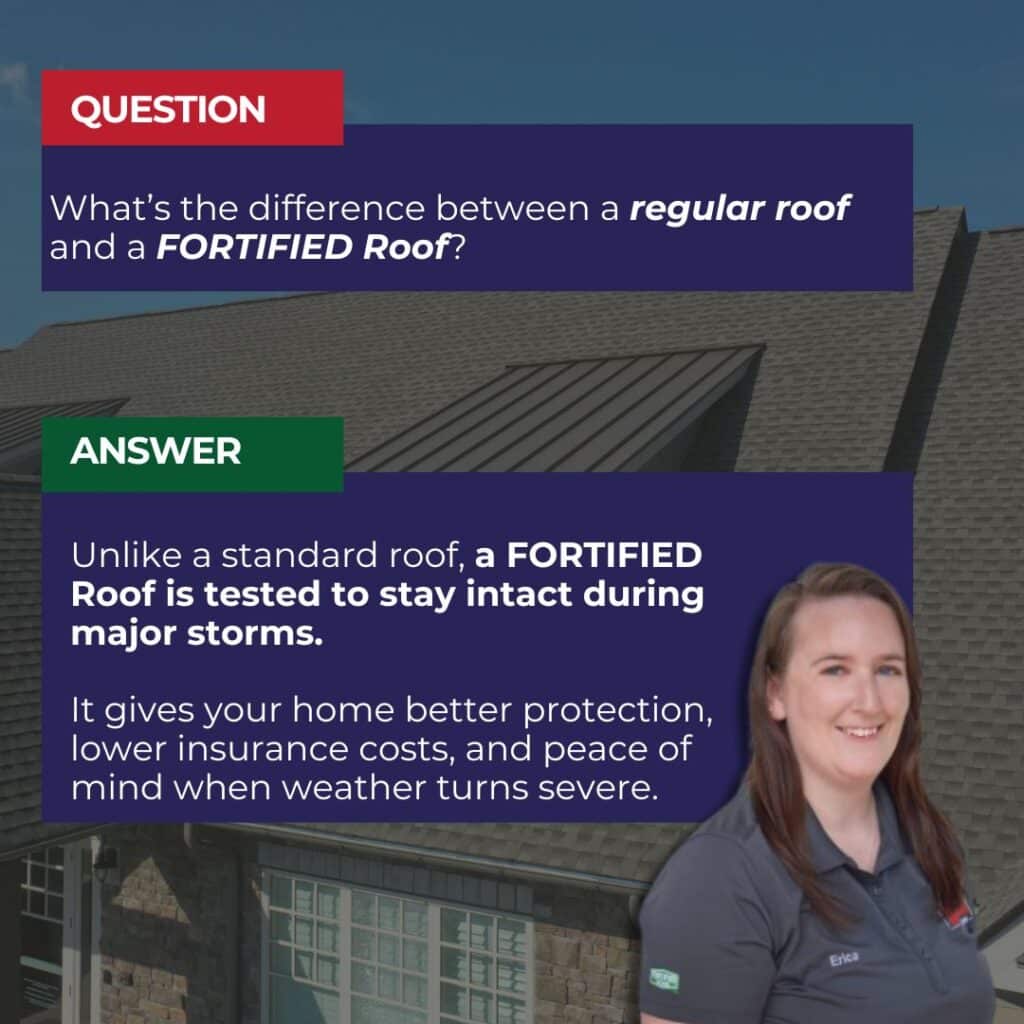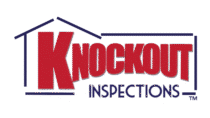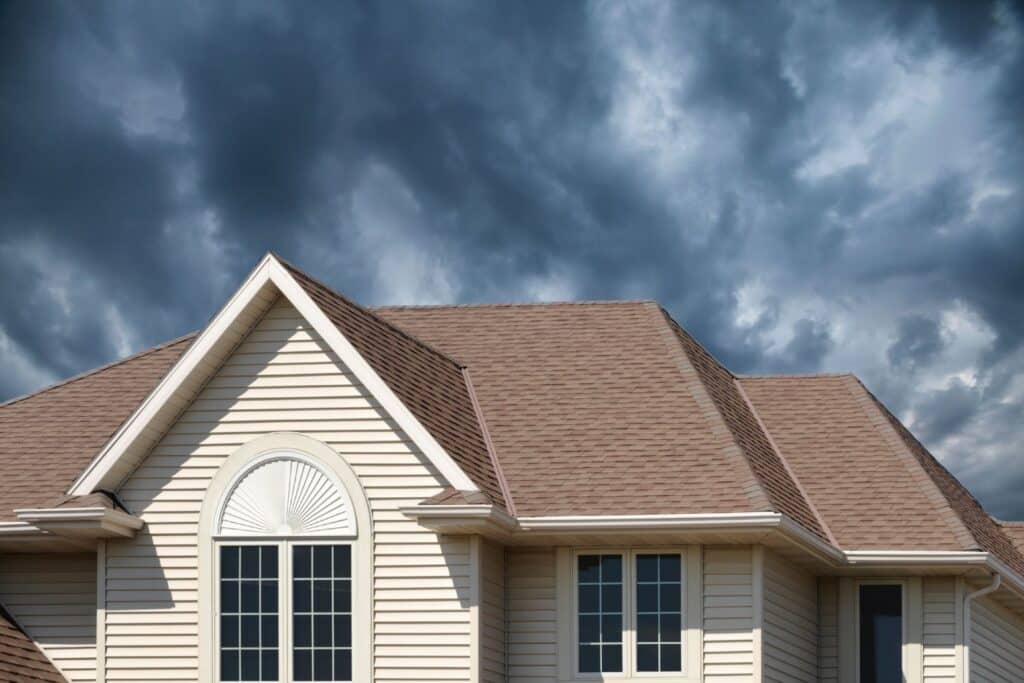For homeowners across the Gulf Coast, roof damage from hurricanes or tropical storms can be both expensive and stressful. Fortunately, FORTIFIED roofs are changing how homes withstand extreme weather.
A FORTIFIED roof is designed to stand up to strong winds, heavy rain, and flying debris. These systems are built using science-based methods that prevent leaks and structural damage long before they start.
At Knockout, we help homeowners in Alabama, Florida, Mississippi, and Louisiana get certified or renew their FORTIFIED Roof designations under the Insurance Institute for Business & Home Safety (IBHS) program.
This guide answers the most common homeowner questions, explains how the process works, and shows why upgrading to a FORTIFIED roof could be one of the smartest investments you ever make for your home.
What Is a FORTIFIED Roof?
A FORTIFIED Roof is built according to standards set by the Insurance Institute for Business & Home Safety. These standards strengthen roofing systems to protect against wind and water intrusion during hurricanes or other severe storms.
Unlike typical roofs that prioritize appearance, a FORTIFIED roof focuses on performance, longevity, and safety. It’s not just about thicker shingles. It’s about building the entire system to resist uplift, leakage, and failure.
The IBHS FORTIFIED program has three levels:
| Level | Protection Scope | Best For |
| Roof | Reinforces the roof deck and edges, sealing gaps to stop water intrusion. | Homeowners upgrading existing roofs. |
| Silver | Adds stronger opening protections and improves roof-to-wall connections. | Homes in moderate-risk areas. |
| Gold | Fortifies the full structure from roof to foundation. | Coastal homes or areas with frequent hurricanes. |
Each level is verified through inspection and documentation. This ensures the roof meets strict performance standards before a certification is issued.

How a FORTIFIED Roof Protects Your Home
FORTIFIED roofs are designed using real-world testing data from IBHS research facilities. These systems can reduce damage by up to 35% during severe wind events, according to IBHS and NOAA studies.
Here’s how the improvements make a difference:
1. Keeps Water Out
A sealed roof deck prevents rain from entering even if shingles blow off. Water intrusion is one of the leading causes of interior damage after hurricanes, often leading to costly mold and structural repairs.
2. Withstands Higher Wind Loads
FORTIFIED roofs are tested for sustained winds up to 130 mph, the equivalent of a Category 3 hurricane. Enhanced fasteners, edge metal, and deck adhesives work together to stop uplift and shingle loss.
3. Strengthens Roof-to-Wall Connections
By reinforcing where the roof meets the walls, the entire home resists uplift pressure better. This prevents the cascading damage that can happen when a roof separates from the structure.
4. Reduces Repair Costs and Insurance Claims
As cited above, homes built or upgraded to FORTIFIED standards experience fewer roof replacements and smaller insurance claims over time. The IBHS reports that FORTIFIED homes recover faster and more affordably after hurricanes than non-FORTIFIED homes.
5. Extends Roof Lifespan
Because materials are stronger and moisture-resistant, FORTIFIED roofs last longer than traditional roofing systems. Many homeowners see an additional 10–15 years of service life, depending on materials and maintenance.
Source: Insurance Institute for Business & Home Safety; NOAA Hurricane Research Division
Cost and Savings of a FORTIFIED Roof
The cost of upgrading to a FORTIFIED roof depends on materials and home design, but most homeowners see significant returns through insurance savings, extended lifespan, and avoided storm damage.
| Roof Type | Added Upgrade Cost | Potential Insurance Savings |
| Asphalt Shingle | $1,000–$3,000 | 20–35% premium reduction |
| Metal Roof | $2,500–$5,000 | 25–40% premium reduction |
| Tile Roof | $4,000–$7,000 | 15–25% premium reduction |
Several Gulf Coast states, including Alabama, have grant and rebate programs that help homeowners offset costs. The Strengthen Alabama Homes program, for instance, reimburses up to $10,000 toward FORTIFIED upgrades.
Because of these incentives, many homeowners recoup the upgrade cost within 3 to 5 years, particularly when combining insurance discounts and reduced repair expenses.
FORTIFIED Certification and Renewal
Every FORTIFIED roof requires professional inspection and documentation to earn official certification. At Knockout Inspections, we conduct both initial certifications and renewals for existing FORTIFIED Roofs.
Initial Certification:
- Verifying deck sealing and nail patterns
- Confirming underlayment and edge attachment
- Inspecting flashing and ventilation
- Photographing and documenting each compliance step for IBHS records
Once approved, the certification is valid for five years. Before it expires, a renewal inspection confirms that the roof is still in compliance and that no weather or repair work has affected its integrity.
Renewal Inspections:
- Roof condition and any repairs since certification
- Edge metal and sealing quality
- Fastener performance and shingle adhesion
- Updated compliance documentation for insurance providers
Benefits of a FORTIFIED Roof Certification
Beyond protecting your home, a certified FORTIFIED Roof offers several major benefits:
1. Lower Insurance Premiums
Many insurance providers in Alabama, Florida, and Louisiana offer premium discounts of 20–40% for homes with active FORTIFIED certifications. Over time, this can amount to thousands of dollars in savings.
2. Greater Home Value and Buyer Confidence
A FORTIFIED certification adds immediate appeal to home listings. Buyers know the property meets a verified safety standard that can help protect their investment.
3. Grant and Loan Incentives
Programs like Strengthen Alabama Homes and similar state initiatives offer grants or zero-interest loans for FORTIFIED upgrades. Some mortgage lenders even provide favorable terms for certified homes.
4. Reduced Long-Term Maintenance
Because FORTIFIED roofs are designed for durability, homeowners spend less on recurring patchwork or replacement cycles. This means fewer disruptions and lower lifetime costs.
5. Energy and Moisture Efficiency
FORTIFIED systems naturally improve attic airflow and reduce leaks, which can help keep humidity in check and improve HVAC efficiency, especially in humid coastal climates.
FORTIFIED Roof vs. Standard Roof
| Feature | Standard Roof | FORTIFIED Roof |
| Roof Deck | May have gaps or unsealed joints | Fully sealed with adhesive underlayment |
| Fasteners | Basic smooth nails | Ring-shank nails or screws for better hold |
| Edge Design | Minimal drip edge | Reinforced, sealed metal edges |
| Shingle Type | Standard | Impact-resistant, wind-tested shingles |
| Wind Resistance | Up to 90 mph | Up to 130 mph (Category 3 equivalent) |
| Insurance Discount | Minimal | 20–40% in qualifying areas |
Data Sources: IBHS; FEMA Building Science Branch

How to Know if Your Roof Qualifies for FORTIFIED Certification
Not every roof automatically meets FORTIFIED standards, but many can be upgraded during replacement or repair.
If your roof is newer, a professional inspection can determine whether it meets existing FORTIFIED criteria or can be adapted.
Common elements inspectors look for include:
- Roof deck type and attachment pattern
- Underlayment and flashing system
- Nail placement and edge securement
- Vent and seal integrity
If your home was built or reroofed within the last ten years, upgrading to FORTIFIED Roof standards may require only minor changes.
Knockout Inspections provides detailed reports outlining what’s needed for certification or renewal, helping homeowners plan repairs strategically.
Other Common Questions About FORTIFIED Roofs
Can a FORTIFIED Roof Reduce Flood or Hail Damage?
While FORTIFIED standards focus primarily on wind and water intrusion, the upgrades can also reduce secondary damage from hail and rain. Many impact-rated shingles used in FORTIFIED systems perform better against hail than standard roofing.
Do FORTIFIED Roofs Look Different from Regular Roofs?
Not at all. FORTIFIED roofs use the same visible materials (shingles, metal panels, or tiles) but are installed using stronger fastening methods and sealants.
What Happens If I Replace My Roof Before Renewal?
If you replace or significantly repair your roof before your certification period ends, you’ll need a new inspection to maintain FORTIFIED status. Knockout’s inspectors can handle certification renewals quickly.
Can FORTIFIED Standards Apply to Commercial Buildings?
Yes. While originally developed for residential properties, FORTIFIED standards can also apply to small commercial or mixed-use buildings with similar roof structures.
When to Schedule a FORTIFIED Roof Inspection
The best times to schedule a FORTIFIED inspection are:
- Before roof replacement or re-roofing projects
- After major storm events or hurricane seasons
- When your certification is within one year of expiring
Even if you’re not ready for full certification, a FORTIFIED inspection can identify weak points and help you plan upgrades gradually.
Knockout Inspections proudly serves homeowners across Alabama, Florida, Louisiana, and Mississippi with certified FORTIFIED Roof inspections, renewals, and consultations.
Our inspectors are licensed and trained through the IBHS FORTIFIED Evaluator Program, ensuring your roof meets every required standard for insurance and resale value.
Conclusion
A FORTIFIED Roof is more than an extra layer of protection. It’s a complete system built to withstand the Gulf’s toughest weather. From stronger fasteners to water-sealed decks, every component is designed to keep your home standing strong and dry when storms hit.
If you’re considering upgrading your roof or renewing your FORTIFIED certification, contact Knockout Inspections today. Our team will evaluate your roof, explain your options, and help you qualify for insurance discounts and state incentives with confidence.

